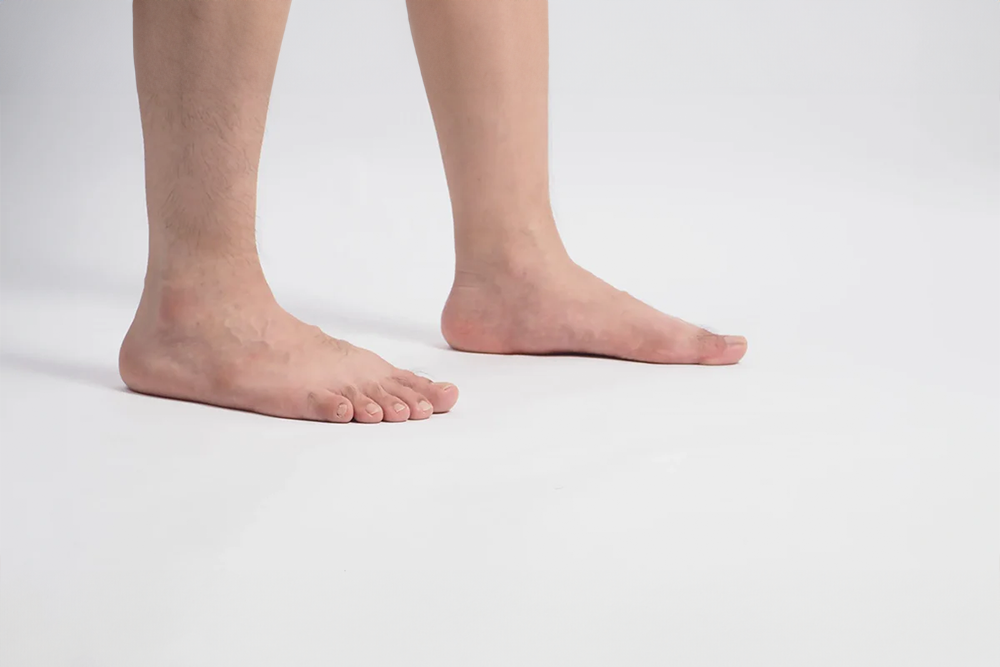WHAT IS FLAT FOOT?
Flat foot, or pes planus, is defined by the absence or reduction of the arch of the foot, the curved part beneath the sole. This condition can lead to decreased stability and natural cushioning of the foot. Symptoms may include pain, fatigue, and inward tilting of the heel. It is recommended to consult a healthcare professional for evaluation and treatment options.
WHY DO SOME PEOPLE HAVE HIGH ARCHES?
Some individuals are born with naturally high arches, but in others, flat feet may be a symptom of an underlying neurological condition, such as:
Cerebral palsy
Muscular dystrophy
Spina bifida
Polio
Post-stroke sequelae
Spinal cord tumor
Charcot-Marie-Tooth disease
In cases of flat feet in children, it is crucial to consult a doctor who can conduct a medical and neurological examination, guiding you to the most qualified healthcare professional to provide appropriate assistance.
HOW CAN I DETERMINE IF I HAVE HIGH ARCHES OR FLAT FEET?
To determine if you have flat feet, you can stand on a large sheet of paper with wet feet. Let the moisture soak into the paper, then remove your feet. If the imprint on the paper shows only the forefoot and heel, without a connection between them, this indicates flat feet. If there is a thin imprint connecting the two, it suggests a moderately high arch.
A healthcare professional such as a podiatrist or orthotic specialist can take foot impressions during a podiatric assessment to determine if you have flat feet, high arches, or standard-shaped feet. Additionally, if necessary, they can design custom orthopedic insoles that you can integrate into orthopedic shoes.
WHAT HEALTH ISSUES ARE ASSOCIATED WITH FLAT FEET?
High arches can cause a range of foot pathologies, depending on the height of your arch and whether it results from an underlying issue or not. Most of these problems are related to how flat feet affect your walking and standing posture. Among them are plantar fasciitis, metatarsalgia, and toe deformities.
If the foot tends to collapse outward as well, it is termed flat varus foot. Unlike flat foot, flat valgus foot is very rare, meaning that it will not tend to collapse inward.
Plantar Fasciitis (Heel Spur): Individuals with high arches may be prone to plantar fasciitis, an inflammation of the ligament connecting the heel to the toes and supporting the foot arch. Pain is usually localized in the heel but may also be felt along the sole of the foot. It is often more intense during the first steps in the morning and tends to lessen with movement. The pain can be described as a burning sensation or a stabbing pain and may intensify after standing or sitting for an extended period. Metatarsalgia: Flat feet are a common cause of metatarsalgia, a painful inflammation of the ball of the foot. Common symptoms include sharp or shooting pain in the ball of the foot when walking, burning sensations under the forefoot, tingling or numbness in the toes, and feeling like there’s a pebble in your shoe. This condition can cause abnormal wear on the soles of your shoes. Claw toes: Claw toes refer to toes that take on a claw-like position and dig into the shoe sole. The joints of the affected toes deform in an unusual manner, causing them to curl downward. Hammer toes: Hammer toe is a deformity that affects the second, third, or fourth toe. It involves flexion of the toe at the middle joint, creating a hammer-like appearance. Initially, the affected toe is flexible. However, over time, it may become rigid and require surgical intervention. Foot and ankle instability: When you have flat feet, the calcaneus, or heel bone, can tilt outward. This leads to foot and ankle instability, which can cause pain and increase the risk of ankle sprains.
HOW TO TREAT FLAT FEET?
To alleviate pain associated with flat feet, several solutions can be considered, including wearing orthopedic insoles, using forefoot cushion pads, and wearing orthopedic shoes. Treatment for flat feet varies depending on the cause and severity of symptoms. It may involve the use of foot orthoses, exercises
